Definition of Research Tools: Positivism, Analysis, and Designs
VerifiedAdded on 2022/11/24
|6
|1152
|196
Homework Assignment
AI Summary
This assignment provides definitions and explanations of several key research tools and methodologies. It begins by defining positivism as a research philosophy emphasizing empirical data and a deductive approach. The assignment then explains structured interviews as a standardized metho...
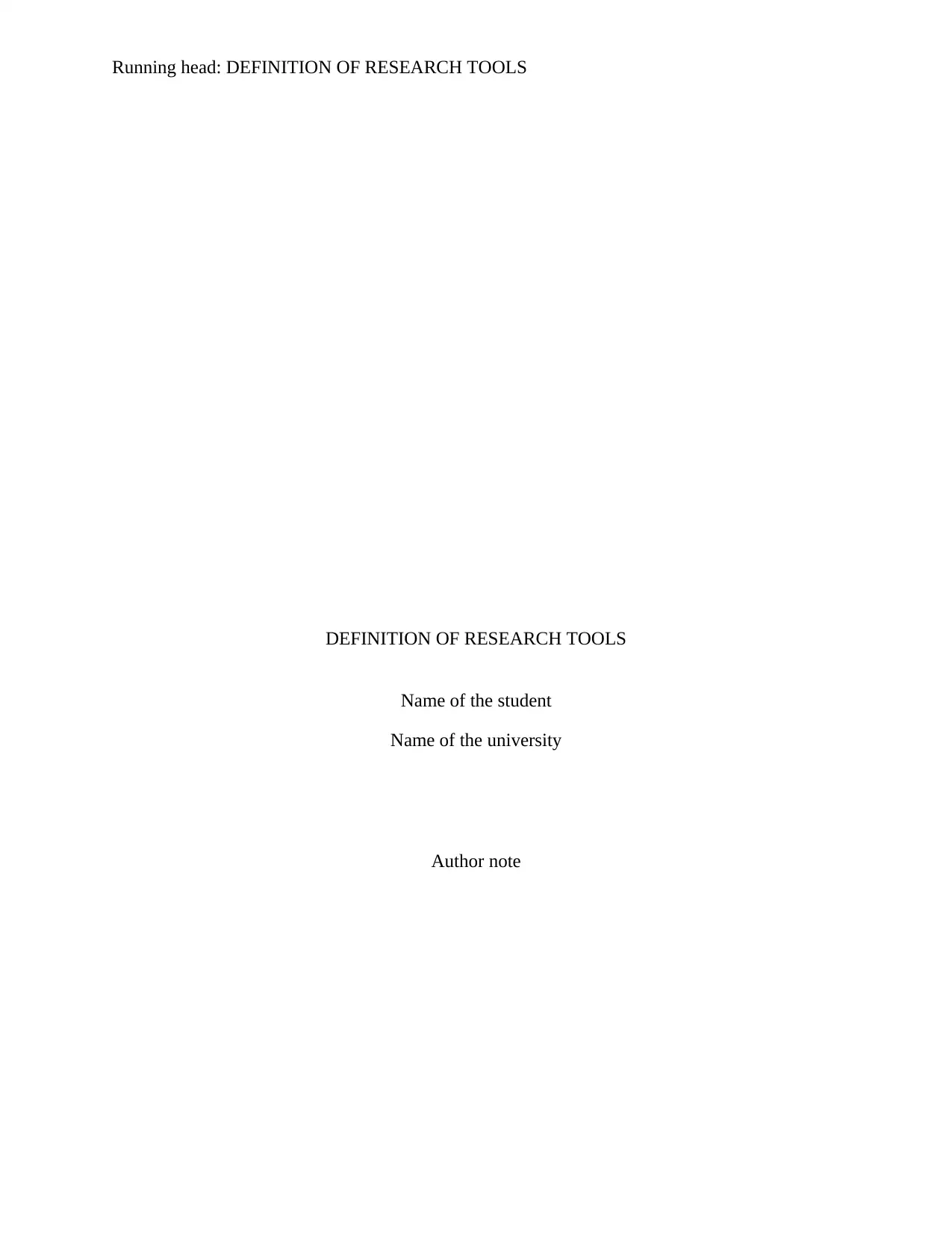
Running head: DEFINITION OF RESEARCH TOOLS
DEFINITION OF RESEARCH TOOLS
Name of the student
Name of the university
Author note
DEFINITION OF RESEARCH TOOLS
Name of the student
Name of the university
Author note
Secure Best Marks with AI Grader
Need help grading? Try our AI Grader for instant feedback on your assignments.
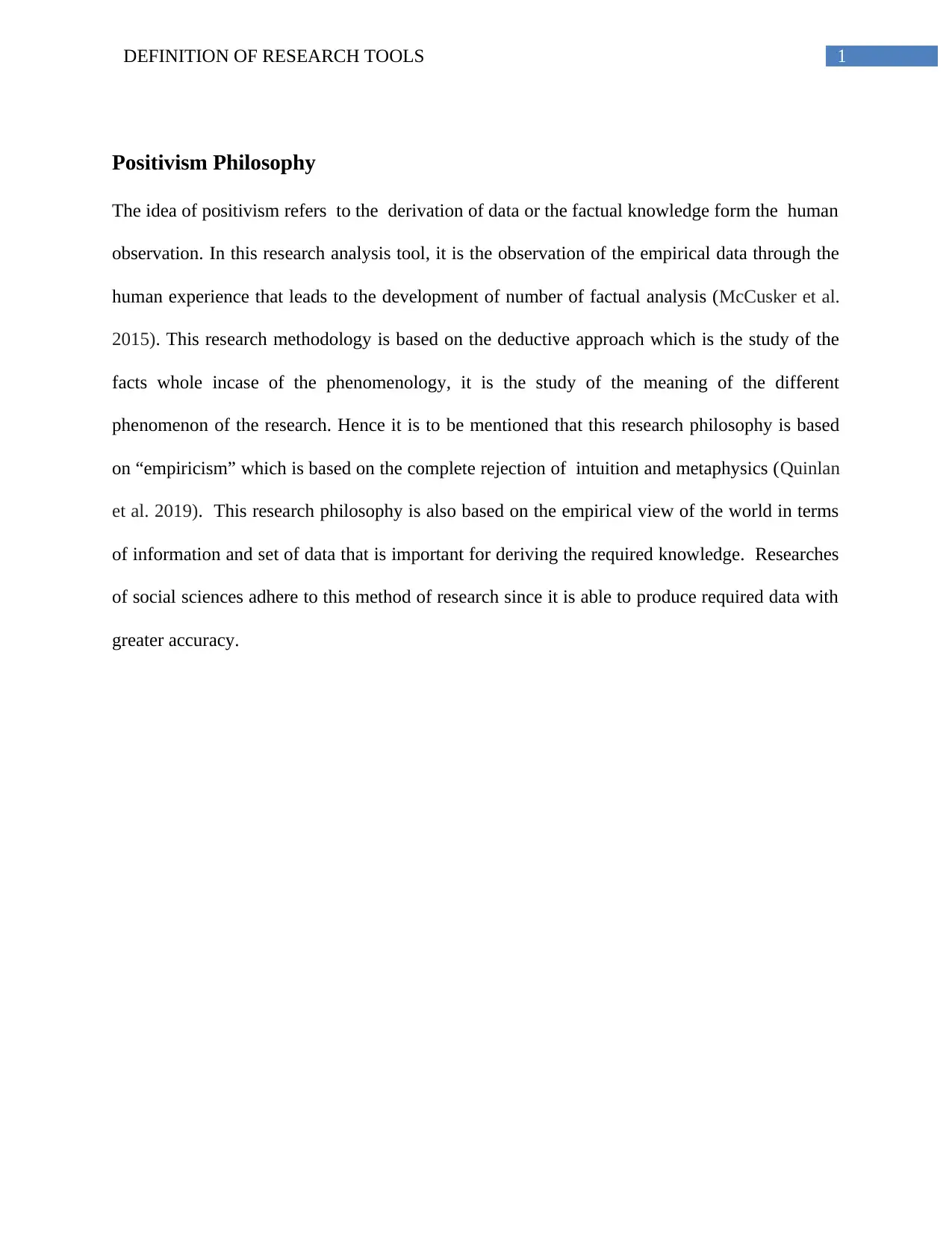
1DEFINITION OF RESEARCH TOOLS
Positivism Philosophy
The idea of positivism refers to the derivation of data or the factual knowledge form the human
observation. In this research analysis tool, it is the observation of the empirical data through the
human experience that leads to the development of number of factual analysis (McCusker et al.
2015). This research methodology is based on the deductive approach which is the study of the
facts whole incase of the phenomenology, it is the study of the meaning of the different
phenomenon of the research. Hence it is to be mentioned that this research philosophy is based
on “empiricism” which is based on the complete rejection of intuition and metaphysics (Quinlan
et al. 2019). This research philosophy is also based on the empirical view of the world in terms
of information and set of data that is important for deriving the required knowledge. Researches
of social sciences adhere to this method of research since it is able to produce required data with
greater accuracy.
Positivism Philosophy
The idea of positivism refers to the derivation of data or the factual knowledge form the human
observation. In this research analysis tool, it is the observation of the empirical data through the
human experience that leads to the development of number of factual analysis (McCusker et al.
2015). This research methodology is based on the deductive approach which is the study of the
facts whole incase of the phenomenology, it is the study of the meaning of the different
phenomenon of the research. Hence it is to be mentioned that this research philosophy is based
on “empiricism” which is based on the complete rejection of intuition and metaphysics (Quinlan
et al. 2019). This research philosophy is also based on the empirical view of the world in terms
of information and set of data that is important for deriving the required knowledge. Researches
of social sciences adhere to this method of research since it is able to produce required data with
greater accuracy.
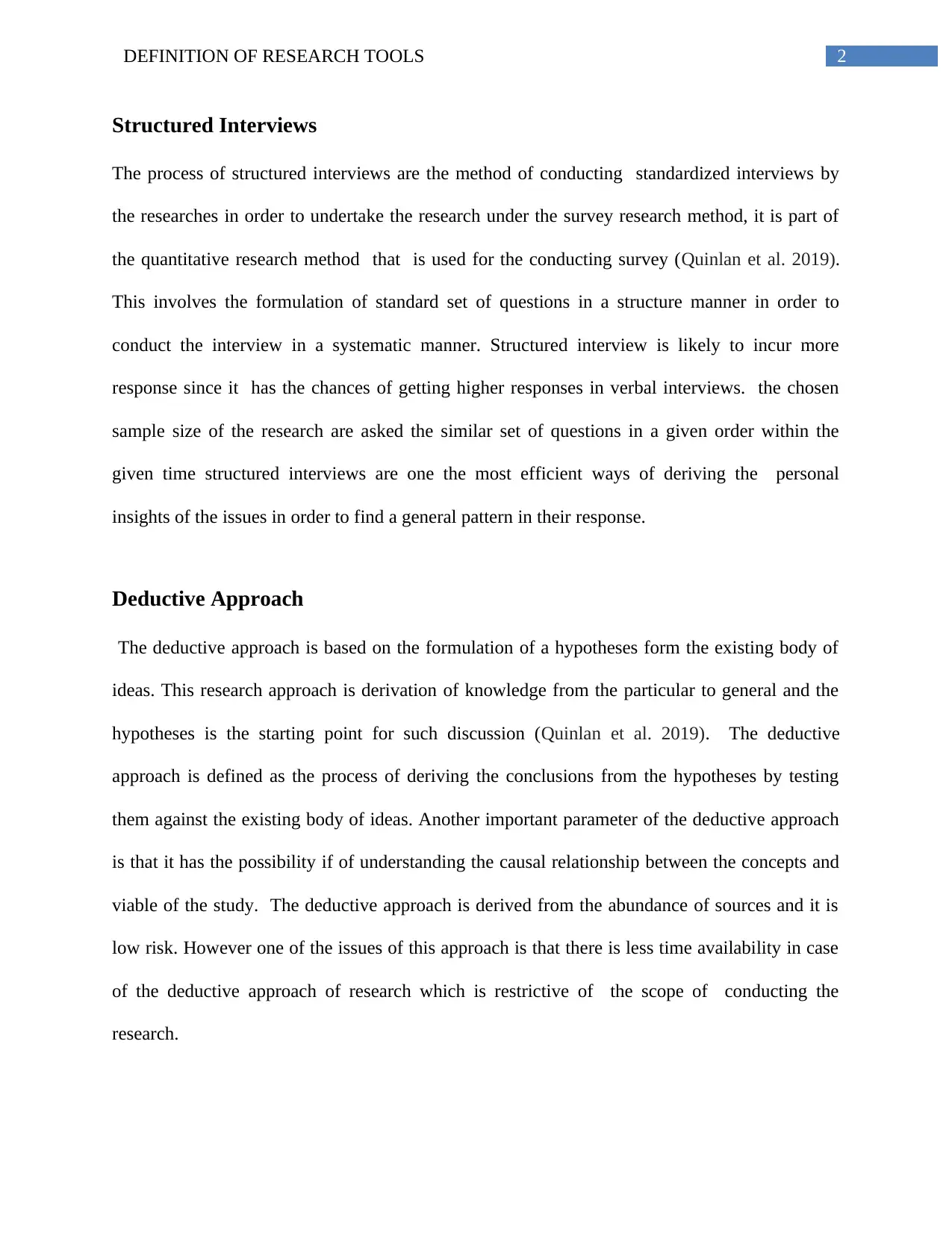
2DEFINITION OF RESEARCH TOOLS
Structured Interviews
The process of structured interviews are the method of conducting standardized interviews by
the researches in order to undertake the research under the survey research method, it is part of
the quantitative research method that is used for the conducting survey (Quinlan et al. 2019).
This involves the formulation of standard set of questions in a structure manner in order to
conduct the interview in a systematic manner. Structured interview is likely to incur more
response since it has the chances of getting higher responses in verbal interviews. the chosen
sample size of the research are asked the similar set of questions in a given order within the
given time structured interviews are one the most efficient ways of deriving the personal
insights of the issues in order to find a general pattern in their response.
Deductive Approach
The deductive approach is based on the formulation of a hypotheses form the existing body of
ideas. This research approach is derivation of knowledge from the particular to general and the
hypotheses is the starting point for such discussion (Quinlan et al. 2019). The deductive
approach is defined as the process of deriving the conclusions from the hypotheses by testing
them against the existing body of ideas. Another important parameter of the deductive approach
is that it has the possibility if of understanding the causal relationship between the concepts and
viable of the study. The deductive approach is derived from the abundance of sources and it is
low risk. However one of the issues of this approach is that there is less time availability in case
of the deductive approach of research which is restrictive of the scope of conducting the
research.
Structured Interviews
The process of structured interviews are the method of conducting standardized interviews by
the researches in order to undertake the research under the survey research method, it is part of
the quantitative research method that is used for the conducting survey (Quinlan et al. 2019).
This involves the formulation of standard set of questions in a structure manner in order to
conduct the interview in a systematic manner. Structured interview is likely to incur more
response since it has the chances of getting higher responses in verbal interviews. the chosen
sample size of the research are asked the similar set of questions in a given order within the
given time structured interviews are one the most efficient ways of deriving the personal
insights of the issues in order to find a general pattern in their response.
Deductive Approach
The deductive approach is based on the formulation of a hypotheses form the existing body of
ideas. This research approach is derivation of knowledge from the particular to general and the
hypotheses is the starting point for such discussion (Quinlan et al. 2019). The deductive
approach is defined as the process of deriving the conclusions from the hypotheses by testing
them against the existing body of ideas. Another important parameter of the deductive approach
is that it has the possibility if of understanding the causal relationship between the concepts and
viable of the study. The deductive approach is derived from the abundance of sources and it is
low risk. However one of the issues of this approach is that there is less time availability in case
of the deductive approach of research which is restrictive of the scope of conducting the
research.
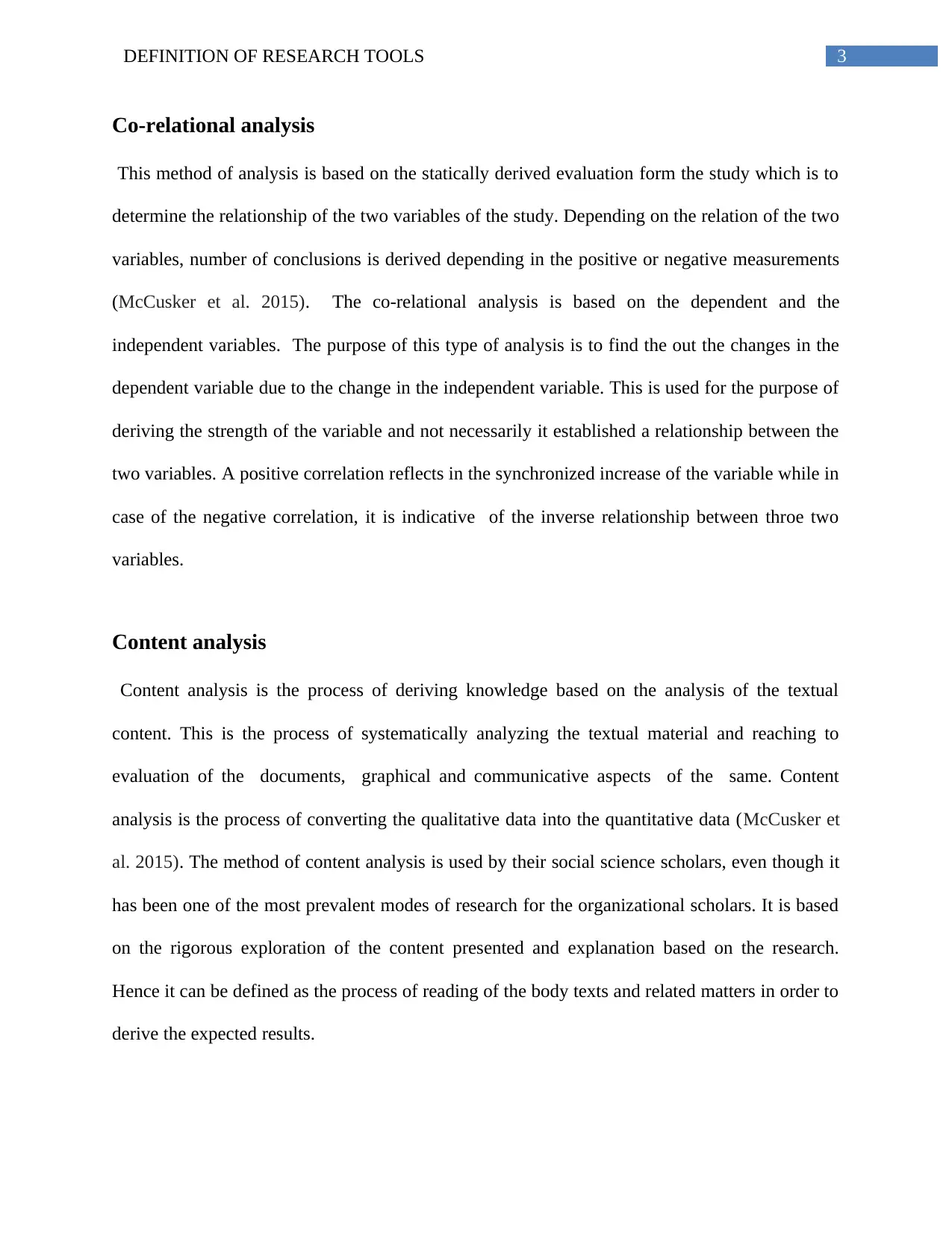
3DEFINITION OF RESEARCH TOOLS
Co-relational analysis
This method of analysis is based on the statically derived evaluation form the study which is to
determine the relationship of the two variables of the study. Depending on the relation of the two
variables, number of conclusions is derived depending in the positive or negative measurements
(McCusker et al. 2015). The co-relational analysis is based on the dependent and the
independent variables. The purpose of this type of analysis is to find the out the changes in the
dependent variable due to the change in the independent variable. This is used for the purpose of
deriving the strength of the variable and not necessarily it established a relationship between the
two variables. A positive correlation reflects in the synchronized increase of the variable while in
case of the negative correlation, it is indicative of the inverse relationship between throe two
variables.
Content analysis
Content analysis is the process of deriving knowledge based on the analysis of the textual
content. This is the process of systematically analyzing the textual material and reaching to
evaluation of the documents, graphical and communicative aspects of the same. Content
analysis is the process of converting the qualitative data into the quantitative data (McCusker et
al. 2015). The method of content analysis is used by their social science scholars, even though it
has been one of the most prevalent modes of research for the organizational scholars. It is based
on the rigorous exploration of the content presented and explanation based on the research.
Hence it can be defined as the process of reading of the body texts and related matters in order to
derive the expected results.
Co-relational analysis
This method of analysis is based on the statically derived evaluation form the study which is to
determine the relationship of the two variables of the study. Depending on the relation of the two
variables, number of conclusions is derived depending in the positive or negative measurements
(McCusker et al. 2015). The co-relational analysis is based on the dependent and the
independent variables. The purpose of this type of analysis is to find the out the changes in the
dependent variable due to the change in the independent variable. This is used for the purpose of
deriving the strength of the variable and not necessarily it established a relationship between the
two variables. A positive correlation reflects in the synchronized increase of the variable while in
case of the negative correlation, it is indicative of the inverse relationship between throe two
variables.
Content analysis
Content analysis is the process of deriving knowledge based on the analysis of the textual
content. This is the process of systematically analyzing the textual material and reaching to
evaluation of the documents, graphical and communicative aspects of the same. Content
analysis is the process of converting the qualitative data into the quantitative data (McCusker et
al. 2015). The method of content analysis is used by their social science scholars, even though it
has been one of the most prevalent modes of research for the organizational scholars. It is based
on the rigorous exploration of the content presented and explanation based on the research.
Hence it can be defined as the process of reading of the body texts and related matters in order to
derive the expected results.
Secure Best Marks with AI Grader
Need help grading? Try our AI Grader for instant feedback on your assignments.
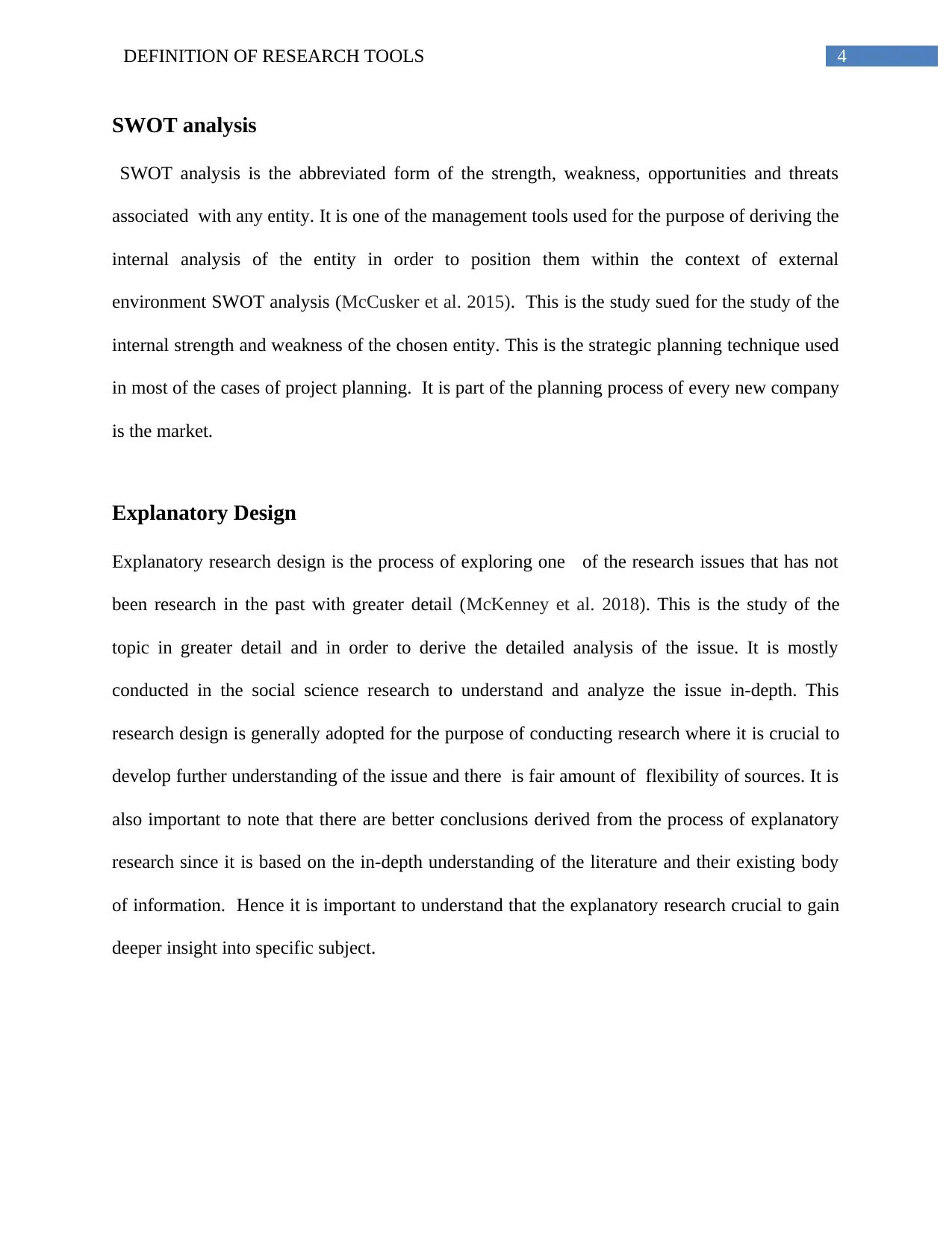
4DEFINITION OF RESEARCH TOOLS
SWOT analysis
SWOT analysis is the abbreviated form of the strength, weakness, opportunities and threats
associated with any entity. It is one of the management tools used for the purpose of deriving the
internal analysis of the entity in order to position them within the context of external
environment SWOT analysis (McCusker et al. 2015). This is the study sued for the study of the
internal strength and weakness of the chosen entity. This is the strategic planning technique used
in most of the cases of project planning. It is part of the planning process of every new company
is the market.
Explanatory Design
Explanatory research design is the process of exploring one of the research issues that has not
been research in the past with greater detail (McKenney et al. 2018). This is the study of the
topic in greater detail and in order to derive the detailed analysis of the issue. It is mostly
conducted in the social science research to understand and analyze the issue in-depth. This
research design is generally adopted for the purpose of conducting research where it is crucial to
develop further understanding of the issue and there is fair amount of flexibility of sources. It is
also important to note that there are better conclusions derived from the process of explanatory
research since it is based on the in-depth understanding of the literature and their existing body
of information. Hence it is important to understand that the explanatory research crucial to gain
deeper insight into specific subject.
SWOT analysis
SWOT analysis is the abbreviated form of the strength, weakness, opportunities and threats
associated with any entity. It is one of the management tools used for the purpose of deriving the
internal analysis of the entity in order to position them within the context of external
environment SWOT analysis (McCusker et al. 2015). This is the study sued for the study of the
internal strength and weakness of the chosen entity. This is the strategic planning technique used
in most of the cases of project planning. It is part of the planning process of every new company
is the market.
Explanatory Design
Explanatory research design is the process of exploring one of the research issues that has not
been research in the past with greater detail (McKenney et al. 2018). This is the study of the
topic in greater detail and in order to derive the detailed analysis of the issue. It is mostly
conducted in the social science research to understand and analyze the issue in-depth. This
research design is generally adopted for the purpose of conducting research where it is crucial to
develop further understanding of the issue and there is fair amount of flexibility of sources. It is
also important to note that there are better conclusions derived from the process of explanatory
research since it is based on the in-depth understanding of the literature and their existing body
of information. Hence it is important to understand that the explanatory research crucial to gain
deeper insight into specific subject.
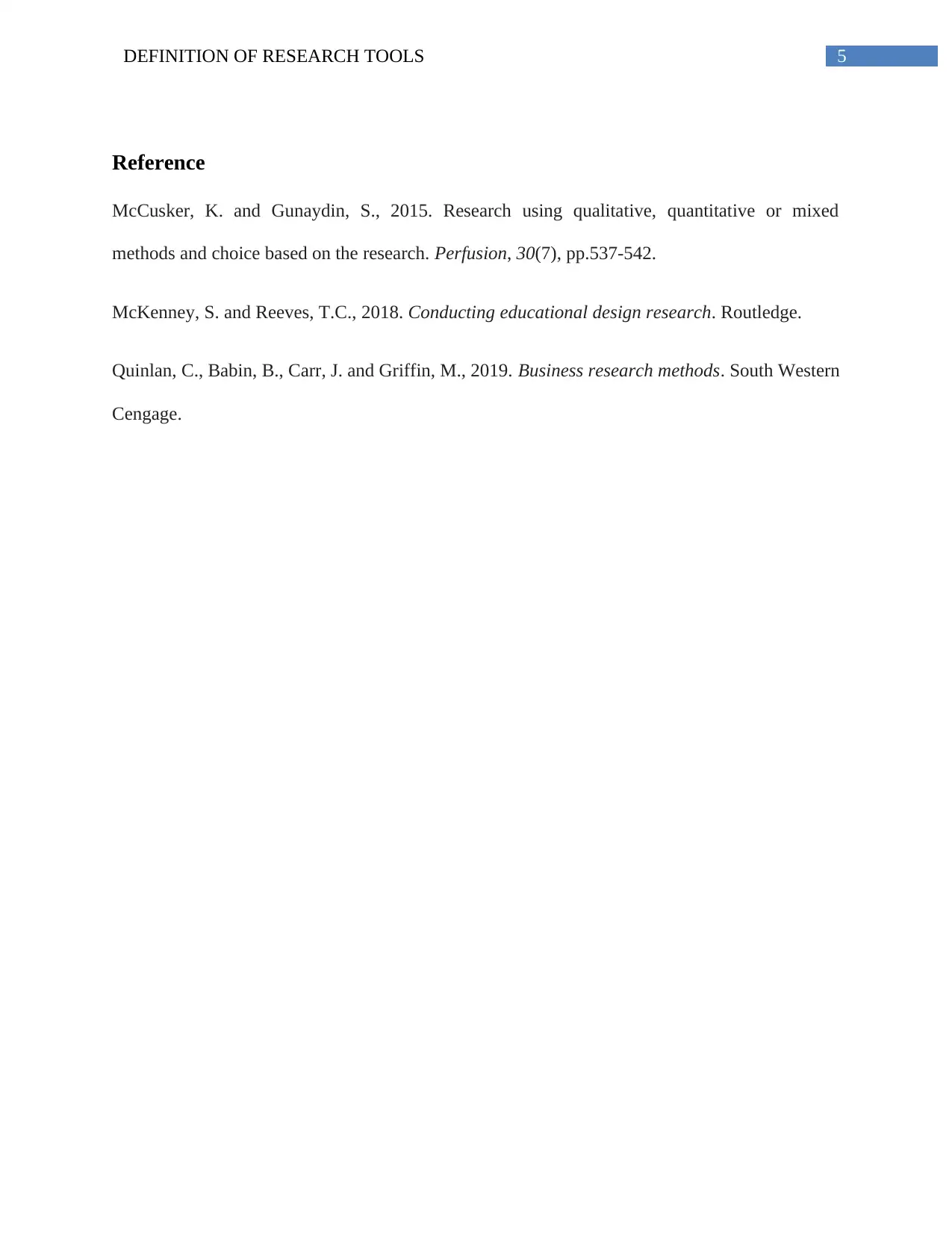
5DEFINITION OF RESEARCH TOOLS
Reference
McCusker, K. and Gunaydin, S., 2015. Research using qualitative, quantitative or mixed
methods and choice based on the research. Perfusion, 30(7), pp.537-542.
McKenney, S. and Reeves, T.C., 2018. Conducting educational design research. Routledge.
Quinlan, C., Babin, B., Carr, J. and Griffin, M., 2019. Business research methods. South Western
Cengage.
Reference
McCusker, K. and Gunaydin, S., 2015. Research using qualitative, quantitative or mixed
methods and choice based on the research. Perfusion, 30(7), pp.537-542.
McKenney, S. and Reeves, T.C., 2018. Conducting educational design research. Routledge.
Quinlan, C., Babin, B., Carr, J. and Griffin, M., 2019. Business research methods. South Western
Cengage.
1 out of 6
Related Documents
Your All-in-One AI-Powered Toolkit for Academic Success.
+13062052269
info@desklib.com
Available 24*7 on WhatsApp / Email
![[object Object]](/_next/static/media/star-bottom.7253800d.svg)
Unlock your academic potential
© 2024 | Zucol Services PVT LTD | All rights reserved.





